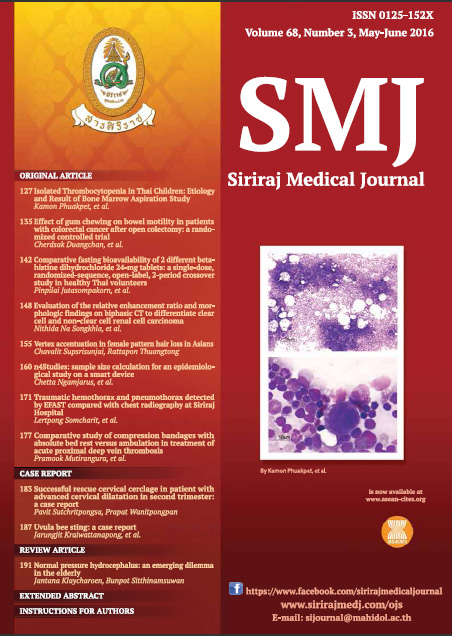Comparative Fasting Bioavailability of 2 Different Betahistine Dihydrochloride 24-mg Tablets: A Single-Dose, Randomized-Sequence, Open-Label, 2-Period Crossover Study in Healthy Thai Volunteers
Keywords:
Betahistine dihydrochloride, bioequivalenceAbstract
Objective: To evaluate the bioequivalence of 24 mg betahistine dihydrochloride tablets between the test product (Stei®) and the reference product (Serc®) in healthy Thai volunteers.
Methods: This was an open-label, randomized sequence, single-dose, two-period crossover study in 24 healthy volunteers. Half of the volunteers received a single dose of test product 24 mg and then reference product 24 mg after a minimum 7-day washout period. The remaining half of volunteers received the reference product first and then the test product with the same washout period. Blood samples were obtained at pre-dose and over 14 hours after dosing. Plasma concentrations of 2-pyridylacetic acid (2-PAA), a major metabolite of betahistine were quantified by using liquid chromatography with tandem mass spectrometry (LC-MS/MS). Tolerability in volunteers was assessed during the study.
Results: Statistical comparison of the main pharmacokinetic parameters showed no significant difference between test and reference. The geometric mean ratios of 2-PAA between the test and reference products were 96.44%, 96.99%, and 94.56% for Cmax, AUC0-t, and AUC0-∞, respectively. These pharmacokinetic parameter values lie within the FDA and European Medicines Agency specified bioequivalence limit (80-125%). No serious adverse events related to the studied drugs were found.
Conclusion: It can be concluded that these two betahistine dihydrochloride products were considered bioequivalent.
Downloads
Published
How to Cite
Issue
Section
License
Authors who publish with this journal agree to the following conditions:
Copyright Transfer
In submitting a manuscript, the authors acknowledge that the work will become the copyrighted property of Siriraj Medical Journal upon publication.
License
Articles are licensed under a Creative Commons Attribution-NonCommercial-NoDerivatives 4.0 International License (CC BY-NC-ND 4.0). This license allows for the sharing of the work for non-commercial purposes with proper attribution to the authors and the journal. However, it does not permit modifications or the creation of derivative works.
Sharing and Access
Authors are encouraged to share their article on their personal or institutional websites and through other non-commercial platforms. Doing so can increase readership and citations.











